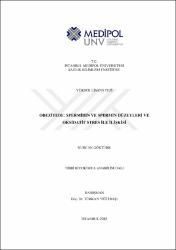| dc.contributor.advisor | Yiğitbaşı, Türkan | |
| dc.contributor.author | Göktürk, Nurcan | |
| dc.date.accessioned | 2021-06-01T06:50:22Z | |
| dc.date.available | 2021-06-01T06:50:22Z | |
| dc.date.issued | 2017 | en_US |
| dc.date.submitted | 2017-01-13 | |
| dc.identifier.citation | Göktürk, N. (2017). Obezitede spermidin ve spermin düzeyleri ve oksidatif stres ile ilişkisi. (Yayınlanmamış yüksek lisans tezi). İstanbul Medipol Üniversitesi Sağlık Bilimleri Enstitüsü, İstanbul. | en_US |
| dc.identifier.uri | https://hdl.handle.net/20.500.12511/6996 | |
| dc.description.abstract | Bu çalışmada obezitede spermidin ve spermin düzeylerini ve bunların oksidatif stres ile ilişkisini araştırmayı amaçladık. Çalışmada, Medipol Üniversitesi Mega Medipol Hastanesi Laboratuvarına başvuran hastaların rutin tetkik olarak alınan kanlarından elde edilen serumlar kullanıldı. 85'i obez, 29 kontrol olmak üzere, toplam 114 birey çalışmaya katıldı. Elde edilen serumlardan glukoz, HbA1c, CRP, üre, ürik asit, CobasRoche 6000 otoanalizöründe immunokemüliminesans yöntemiyle kantitatif olarak; hemogram ise Symex 2000i cihazında flowsitometrik yöntemle çalışıldı. TOS, TAK düzeyleri Erel tarafından geliştirilen metodla spektrofotometrik olarak, spermidin ve spermin düzeyleri ise HPLC metodu ile çalışıldı. Spermidin düzeyleri olgu (1,80±0,68) grubunda, kontrol (2,29±0,79) grubuna göre istatistiksel olarak anlamlı şekilde düşük bulundu (p<0,05). Subgrup analizinde; diyabetik obezlerde, diyabetik olmayan obez gruba göre spermidin düzeylerinin istatistiksel olarak anlamlı şekilde yükseldiği (p<0,05) ancak kontrol grubundan farklı olmadığı gözlendi (p>0,05). Spermin düzeylerinde olgu (6,73) grubu ile kontrol (6,59) grubu arasında istatistiksel olarak anlamlı bir farklılık bulunmadı (p>0,05). Subgrup analizinde; diyabetik olmayan obez grupta spermin düzeyleri kontrol ve diyabetik obez grubuna göre rakamsal olarak düşük bulunmakla beraber, grublar arasında istatistiksel farklılık gözlenmedi (p>0,05). Olgu grubu ile kontrol grubu kıyaslandığında, TAK değerlerinde istatistiksel fark yok iken, TOS değerleri olgu grubunda istatistiksel olarak yüksek bulundu (p<0,05). Sonuç olarak; çalışmamız obez erişkinlerde spermidin ve spermin düzeyini ölçen literatürdeki ilk çalışmadır. Obezitede spermidin ve spermin değerleri kontrol grubuna göre düşük bulunmuş, ancak diyabetik obezlerde artan oksidatif stresle beraber spermin ve spermidin düzeylerinin de yükseldiği gözlenmiştir. BKI ile spermidin arasındaki negatif yönlü korelasyon spermidin düzeyinin düşüklüğünün obeziteyi arttırdığını düşündürmektedir. Spermidin ve spermin düzeyindeki farklılığın nedenini araştırmak amacıyla poliamin yapım ve yıkımında rol alan enzim düzeylerinin ölçüldüğü yeni çalışmalara ihtiyaç vardır. | en_US |
| dc.description.abstract | In this study, we aimed to investigate spermidine and spermine levels and their relationship with oxidative stress in obesity. A total of 114 individuals participated in the study.85 of these were obese, while 29 were normal. In the sera, glucose, HbA1c, CRP, urea and uric acid were examined using the immunochemiluminescence method, and hemogram was performed using the Flowcytometric method. TOS and TAK values were examined spectrophotometrically using the method developed by Erel, while spermidine and spermine levels were examined using the HPLC method. Spermidine levels were found to be lower in the case group (1.80±0.68) at a statistically significant level, compared to the control group (2.29±0.79) (p<0.05). In subgroup analysis, spermidine levels were found to increase in a statistically significant trend (p<0.05) compared to the non-diabetic obese group, but not differently from control group (p>0.05) in diabetic obese individuals. No statistically significant difference was found between the spermine levels in the case (6.73) and the control groups (6.59) (p>0.05). In the subgroup analysis, spermine levels in the non-diabetic obese group were found numerally lower compared to those of the control and diabetic obese groups. However, no statistical difference was observed among the groups (p>0.05). When the control group was compared with the case, there was no statistical difference in TAK values, whereas TOS values were found statistically higher in the case group (p<0.05). As a result, our study is the first in the literature to measure spermidine and spermine levels in obese adults. Spermidine and spermine values were found to be lower in the case group than in the control group, but it was also observed that spermine and spermidine levels also increased with increasing oxidative stress in diabetic obese. The negative correlation between the BMI and spermidine suggests that low spermidine levels increase obesity. In order to investigate the cause of the differences in spermidine and spermine levels, new studies should be carried out in which enzymes involved in the production and degradation of polyamines are examined. | en_US |
| dc.language.iso | tur | en_US |
| dc.publisher | İstanbul Medipol Üniversitesi Sağlık Bilimleri Enstitüsü | en_US |
| dc.rights | info:eu-repo/semantics/openAccess | en_US |
| dc.subject | Obezite | en_US |
| dc.subject | Oksidatif Stres | en_US |
| dc.subject | Spermidin | en_US |
| dc.subject | Spermin | en_US |
| dc.subject | TAK | en_US |
| dc.subject | TOS | en_US |
| dc.subject | OSİ | en_US |
| dc.subject | Obesity | en_US |
| dc.subject | Oxidative Stress | en_US |
| dc.subject | Spermidine | en_US |
| dc.subject | Spermine | en_US |
| dc.subject | TAK | en_US |
| dc.subject | TOS | en_US |
| dc.subject | OSI | en_US |
| dc.title | Obezitede spermidin ve spermin düzeyleri ve oksidatif stres ile ilişkisi | en_US |
| dc.title.alternative | Spermidine and spermine levels and their relationship with oxidative stress in obesity | en_US |
| dc.type | masterThesis | en_US |
| dc.department | İstanbul Medipol Üniversitesi, Sağlık Bilimleri Enstitüsü, Biyokimya Ana Bilim Dalı | en_US |
| dc.relation.publicationcategory | Tez | en_US |


















